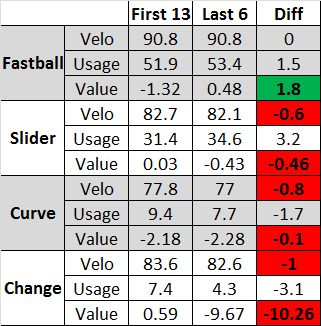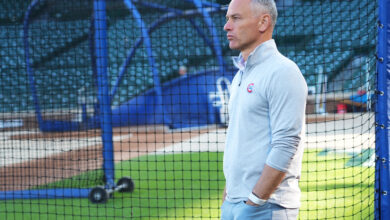
The Myth of John Lackey’s Improved Performance
Over his last six starts, John Lackey has a 3-2 record and has posted three quality starts (at least 6 IP and 3 or fewer ER) with two others that met the runs requirement (1 and 2, respectively) but fell short on innings (5 IP each). Given that he only had four quality starts among his first 13 outings, there’s perhaps reason to believe the misanthropic pitcher has turned a corner and can hold down the back end of the rotation.
But has he really been pitching better or is it just an optical illusion? Though the box score will tell you Lackey earned a win by limiting the White Sox to two earned runs over five innings, the reality is that his outing was barely being held together by duct tape and bubble gum. He hit four batters, three of which loaded the bases in the 5th inning, and opened the 6th with a walk and a double before exiting and being bailed out by Carl Edwards Jr.
Let’s take a quick look at some of the peripheral stats from Lackey’s last six starts as compared to his first 13 and see if we can find anything that stands out (which we probably can because I’ve highlighted them).
The decrease in home runs is definitely a good sign, as is the ERA that’s nearly one run lower. That latter figure, though, isn’t really indicative of Lackey’s true performance. As we can see from a FIP that’s approaching 6.00, that ERA is probably a myth being fueled by an unsustainably low .233 BABIP. Though he’s been generating more soft and less hard contact, a return to his career (.301) and league (.300) BABIP averages will see Lackey’s ERA rise again.
Also telling is the stark drop-off in strikeouts, which are down roughly 41 percent in the more recent sample. Walks are up too, though not alarmingly so. Some of these stats can be a little tricky to deal with, as we too often view variance in BABIP and FIP numbers from the norm and assume that a player is benefiting from or being hurt by luck of some sort.
As the Cubs have gotten their defense back in order, BABIP numbers are naturally going to fall. And giving up more ground balls and less hard contact means that Lackey will reap the benefits of the gloves backing him. Still, some of these numbers are hard to justify with just improved defense.
Let’s turn, then, to Lackey’s various pitches and the results he’s getting from them. Using mainly a fastball/slider combo, he’ll work in a curve and change for a little variety. But he’s gotten away from those secondaries to a large degree of late as their efficacy has fallen off (value numbers are on a per-100-pitch basis).
The fastball is the only pitch that has actually improved in terms of value, but it’s still very pedestrian. In order to provide a little better understanding for those of you who may not be familiar, the numbers in the “Value” column represent how many runs are saved by that given offering for every 100 times it’s thrown. So Lackey’s fastball saves a little less than half a run every two games or so.
But that’s great when compared to the others, all of which cost runs. Some of that can no doubt be attributed to a drop in velocity for every non-fastball he throws. Changes of one mile per hour or less might not seem like much, but we’re talking about a guy who doesn’t have a lot of margin for error to begin with. Each hundredth of a second or inch could spell disaster when it comes to pitch speed and location.
Speaking of, let’s take a look at that really quickly. The heat maps below show us where Lackey’s been throwing relative to the two samples we’re examining here. Note the way he’s elevating a little and coming more in to right-handed hitters.
Despite allowing lower batting averages and slugging percentages from lefties and righties alike over the last six games, Lackey has allowed hitters to reach base at a higher clip than in his first 13 starts. As such, OPS numbers are down less than 10 points overall in the more recent sample. That doesn’t spell good things.
Alright, cool, so we can all agree that Lackey is actually pitching poorly and that the inevitable loss of good luck and subsequent fall to earth means the Cubs need to go out and get another starting pitcher right now. Okay, not really, but it does appear as though the 38-year-old is due for a correction here pretty soon. He might not be as bad he looked earlier in the season, but he’s not as good as some of the recent results are making him seem.
And that’s where the Cubs are in something of a predicament when it comes to adding to the roster. Lackey may have said it with a smirk, but he’s not moving to the bullpen. So unless the plan is to run with a six-man rotation in the second half, acquiring a starter means designating Lackey. Or maybe trading him as a move to help offset a little salary and make the roster work. That’s an easy choice for a lot of fans to make, but it’s less so for the front office.
They’ve got to determine whether the difference between a new starter and Lackey is great enough to justify the prospect cost and, at least in Justin Verlander’s case, the additional salary involved. And perhaps whether it’s worth having to inform Lackey that he’s no longer employed.
But what do you think: Is Lackey’s performance of late legit or is he just getting lucky (John “Lucky” Lackey)? Can he continue to hold down the fifth spot in the rotation and help the Cubs get to the postseason again?





